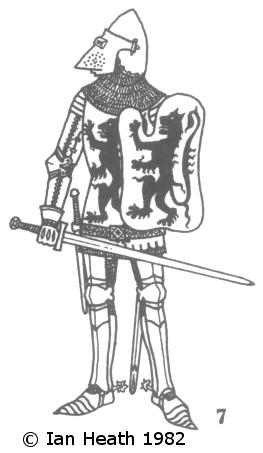
Try Amazon Audible Premium Plus and Get Up to Two Free Audiobooks
SIR GEORGE FELBRIGGE d.1400
An extract from Armies of the Middle Ages, Volume 1by Ian Heath



7. SIR GEORGE FELBRIGGE d.1400
Sir George’s equipment is basically typical of the period 1370-1410. He wears the characteristic close-fitting sleeveless surcoat that is usually called a jupon by modern authorities, even though this term (spelt in a variety of forms, such as gipoun and jupel) was actually already in circulation several decades before this style of surcoat evolved. Such jupons were usually of several layers of material, often if not usually padded, with an outer layer of richer material such as velvet or silk. In fact, they bear a confusing similarity to aketons and gambesons! That of the Black Prince in Canterbury Cathedral has a buckram foundation, a facing of red and blue velvet embroidered in gold, short sleeves that may have once been wrist-length, is stuffed with wool and quilted vertically to a thickness of about ¾", and is laced down the front. Others had the lacing at the back, sides or left side only.
His helmet is of a type called by the English simply a visored bascinet, or occasionally a hounskull, a corruption of its German name of Hundsgugel, meaning ‘hound’s hood’ (hence the description ‘dog-faced’ used of it by many modern authorities). It had come into use by c. 1380, quite probably first appearing some 10-20 years earlier, was in regular use until c.1430 and is still depicted being worn by Western European men-at-arms in Swiss mss. of the late-15th century. The visor, called by Froissart a carnet or visière, had 2 individual outward-flanged eye-slits, and sometimes a similar one over the mouth. It was clearly removable and was frequently not worn in combat because of its impairment of speech, hearing and respiration. We therefore often read of men killed by wounds resulting from its absence, Chandos’ death being a well-known instance.
The legs are now fully armoured like the arms. Plate-armour for the front and outside of the thighs first appeared c. 1360-70 and had soon almost entirely displaced the earlier leather armour. They were secured by straps and buckles behind the knee and thigh, while the greaves were hinged on the outside of the leg and buckled on the inside. The poleyns now have articulations above and below. Both the poleyns and the couters are frequently depicted a gold colour in contemporary illustrations, indicating that they were of latten. Other items of armour that could be of latten included the helmet visor, the entire helmet, the raised ornamental bands such as Sir George has on his arm-harness, the rims of most pieces of plate armour, and gauntlets or at least the gads thereon. In addition mail hauberks and aventails are often depicted edged with 2 or 3 rows of bronze or latten links, even in the 15th century, archaeological evidence of the practice being provided by finds at Wisby.
Shields seem to have declined in use considerably among horsemen as armour increased in weight. The first brass not to show a shield dates to 1347 and the last to show one dates to c. 1360, while few ms. illustrations of the second half of the century show many shields in use by cavalry. Nevertheless, though they became uncommon shields did not entirely disappear by any means, as is witnessed by the shield carried here, based on a 17th century engraving of John of Gaunt’s funeral achievements, that used to hang above his tomb in old St. Paul’s Cathedral. It is of a new rectangular form which first appeared c. 1370, with a notch called a bouché at the upper right-hand corner into which the couched lance was fitted during a charge. An observer of 1610 gives us a good description of this shield’s construction, stating that it was ‘very convex towards the bearer. . . more than three-quarters of a yard in length and about half a yard in breadth; next to the body is a canvas glued to a board, upon that thin board are broad thin axicles, slices or plates of horn, nailed fast, and again over them 26 thick pieces of the like all meeting, or centring, about a round plate of the same, in the navel of the shield, and over all is a leather closed fast to them with glue . . . upon which his arms were painted.’ The heater-shield remained in use alongside this type until the early part of the 15th century, often being similarly bouched after c. 1360.